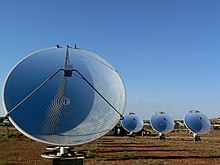
Renewable energy in Australia is mainly based on biomass, solar, wind, and hydro generation. Over a third of electricity is generated from renewables, and is increasing, with a target to phase out coal power before 2040.[1] Wind energy and rooftop solar have particularly grown since 2010. The growth has been stimulated by government energy policy in order to limit the rate of climate change in Australia that has been brought about by the use of fossil fuels. Pros and cons of various types of renewable energy are being investigated, and more recently there have been trials of green hydrogen and wave power.
Australia ratified the Kyoto protocol in 2007, and in 2016 became a party to the Paris Agreement, an international agreement which binds member countries to address climate change. However, the level of fossil fuel subsidies in Australia is still disputed. The Australian Renewable Energy Agency (ARENA) was established as an independent government agency in 2012 to improve the competitiveness of renewable energy technologies and to encourage innovation in the industry. As of 2024[update] renewable energy is seen as a good investment,[2] and many companies operate in Australia, including BP Solar, Eurosolar, Hydro Tasmania, Origin Energy, and Pacific Blue.

| Source | Generation (GWh) |
|---|---|
| Wind | |
| Small solar | |
| Hydro | |
| Large solar | |
| Bioenergy | |
| Medium solar |
- ^ "Coal will be all but gone by 2034 under Australia's latest energy roadmap". UNSW Sites. Retrieved 25 March 2024.
- ^ "Major Investors More Confident in Australia's Climate Policy". Bloomberg. 25 March 2024. Retrieved 25 March 2024.
- ^ Cite error: The named reference
:8was invoked but never defined (see the help page).